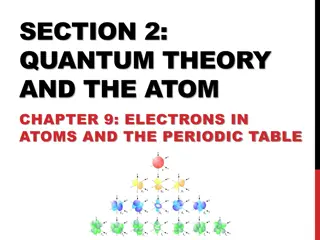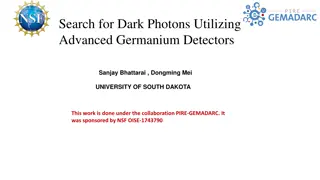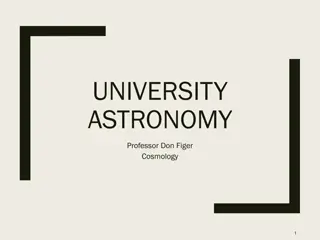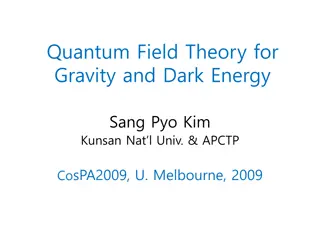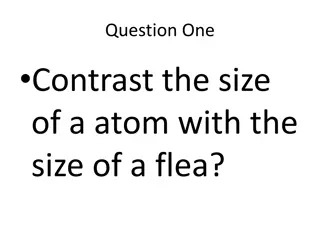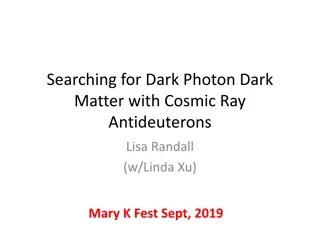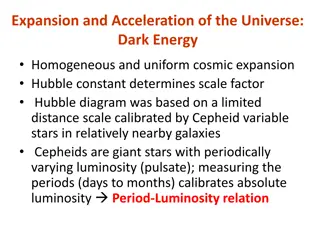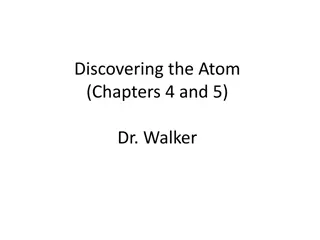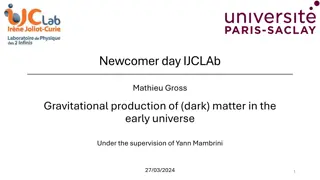Exploring Dark Atom Effects on Structure Formation in the Universe
Overwhelming evidence points towards the existence of dark matter in the universe, with various theoretical models such as OHe atoms and Glashow's EIMP model proposed to explain its nature. Dark OHe atoms, consisting of 2 charged particles bound with primordial He nuclei, offer a unique perspective on dark matter physics. The separation of OHe from plasma during the early universe led to its role as dark matter in the matter-dominated phase. Unlike baryonic matter, OHe does not follow condensation processes, leading to distinctive behaviors in galaxies and clusters.
Download Presentation

Please find below an Image/Link to download the presentation.
The content on the website is provided AS IS for your information and personal use only. It may not be sold, licensed, or shared on other websites without obtaining consent from the author. Download presentation by click this link. If you encounter any issues during the download, it is possible that the publisher has removed the file from their server.
E N D
Presentation Transcript
40 : Effects of Dark Atom in Structure Formation 3- : ( 19-102) : . . . 2021
Dark OHe atoms There is overwhelming evidence for the presence of a dark matter (DM) in the Universe , and together with most popular, but still elusive, weakly interacting massive particle (WIMP), there exist numerous theoretical models including axions, sterile neutrinos, primordial black hole, strongly interacting massive particles, and superweakly interacting particles. Even electromagnetically interacting massive particle (EIMP) candidates are possibly hidden in neutral atomlike states. Dark OHe atoms, in which hypothetical 2 charged particles are bound with primordial He nuclei, occupy a special place on this list. Such models involve only one free parameter of new physics the mass of 2 charged EIMPs so many features of this type of dark matter can be described by the known nuclear and atomic physics.
Glashows EIMP Model In 2005, Glashow proposed a kind of EIMP model, according to which stable teraquarks U (of mass of the order of tera- electron-volts and of electric charge +2/3) form a UUU baryon bound with tera- electrons E of charge 1 in the neutral (UUUEE) atom.
(HeE)+ions He formed in the big bang nucleosynthesis captures all the free E in positively charged (HeE)+ions, preventing a required suppression of the positively charged particles that can bind with electrons in atoms of anomalous hydrogen. In general, stable single charged EIMPs form anomalous hydrogen either directly binding with ordinary electrons (+1 charged EIMPs), or indirectly ( 1 charged EIMPs) forming first +1 charge ion with primordial He and then anomalous hydrogen with ordinary electrons . Therefore, anomalous hydrogen overproduction excludes any significant amount of stable single charged EIMPs.
OHe separation from plasma In the early Universe when temperature fell below 1 keV, the rate of expansion started to exceed the rate of energy and momentum transfer from plasma to OHe gas. As a result, OHe decoupled from plasma and radiation and played the role of dark matter on the matter-dominated stage. The averaged baryonic density in the course of structure formation and in galaxies is sufficiently low, making baryonic matter at large scales transparent for Ohe.
OHe does not follow the condensation For that reason, in the period of formation of the first objects, OHe does not follow the condensation of baryonic matter, so the OHe model avoids constraints from the cosmic microwave background and formation of the first stars . In galaxies and galaxy clusters, OHe behaves like collisionless gas, avoiding constraints from Bullet Cluster observations . Only dense matter objects like stars or planets are opaque for it. The protostellar cloud with the solar mass becomes opaque for OHe.
Why OHe are of special interest? With the lack of evidence for WIMPs in direct and indirect searches for dark matter, the fields of study of possible dark matter physics should be strongly extended. Dark atoms of OHe are of special interest in view of the minimal involvement of new physics in their properties. The hypothesis on stable double charged particle constituents of dark atoms sheds new light on the strategy of dark matter studies, offering a nontrivial explanation for the puzzles of direct and indirect dark matter searches.
Future Study. Dark atoms like OHe are nuclear interacting and lead to a specific type of scenario of large scale structure formation, which I plan to study further.




